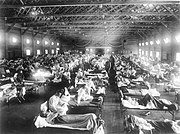Portal:Viruses/Selected outbreak/1

The 1918–20 influenza pandemic, the first of the two involving H1N1 influenza virus, was unusually deadly. It infected 500 million people across the entire globe, with a death toll of 50–100 million (3–5% of the world's population), making it one of the deadliest natural disasters of human history. It has also been implicated in the outbreak of encephalitis lethargica in the 1920s. Despite the nickname "Spanish flu", the pandemic's geographic origin is unknown.
Most influenza outbreaks disproportionately kill young, elderly or already weakened patients; in contrast this predominantly killed healthy young adults. Contemporary medical reports suggest that malnourishment, overcrowded medical facilities and poor hygiene promoted fatal bacterial pneumonia. Some research suggests that the virus might have killed through a cytokine storm, an overreaction of the body's immune system. This would mean the strong immune reactions of young adults resulted in a more severe disease than the weaker immune systems of children and older adults.
